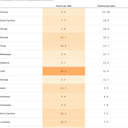U.S. coronavirus hotspots failed to build up public health tools

Published Date: 6/29/2020
Source: axios.com
Data: Nephron and JHU; Table: Axios VisualsMost of the states facing large coronavirus outbreaks today didn't build up their public health systems enough ahead of time.Why it matters: States like Arizona, Florida and Texas had months to learn from the mistakes of New York and other early hotspots, yet find themselves now in similar situations. The big picture: The U.S. has rapidly scaled up its testing and contact tracing capabilities, but they're still not nearly enough.States should have at least 30 contact tracers per 100,000 people during the pandemic, according to the National Association of County and City Health Officials. Most states' workforce falls far short of that metric, according to a Nephron Research analysis.The World Health Organization has said 5% or less of diagnostic tests should come back positive for at least 14 days before governments allow reopening, but many states are now well above this threshold, per Johns Hopkins University.In some hotspots, people are having a hard time getting tested, leading to long lines and crowding, the NYT reports. Overall, the U.S. still isn't doing the number of tests that many experts say it needs to be.Between the lines: Part of the reason the U.S. economy shut down was to buy states time to build up their public health infrastructure. Many states failed to do so before reopening, leading to today's predictable results.The bottom line: There's no reason why any city or state in the U.S. can't eventually become a coronavirus hotspot. Arizona, Texas and Florida are learning this the hard way, but there are plenty of places that still have more time to build up their testing, tracing and isolation capabilities.Go deeper: Bigger, wealthier cities lead on coronavirus recovery